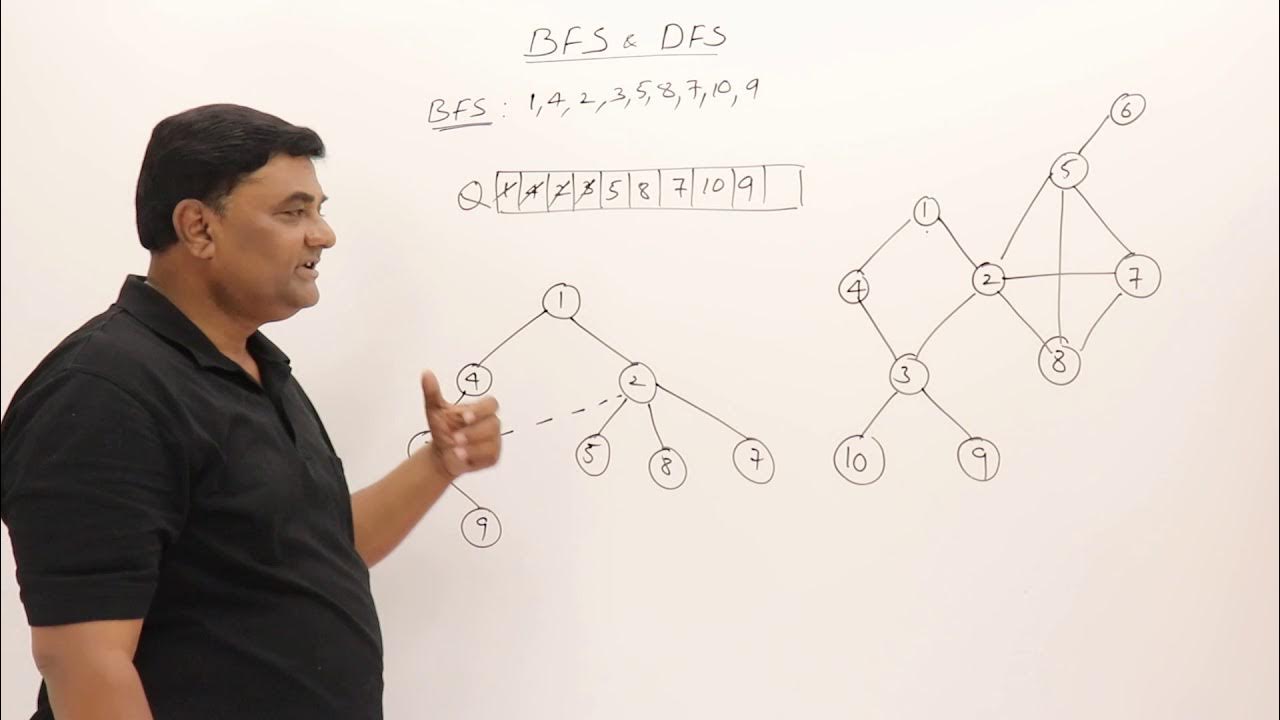[SER222] M04_02 The Directed Cycle Problem (2/4): Finding Cycles 1
Summary
TLDRThis video delves into the process of detecting cycles in both undirected and directed graphs using DFS and BFS. The speaker explains that in undirected graphs, cycles are easily identified when a previously marked node is revisited during traversal. However, in directed graphs, the direction of edges complicates cycle detection, requiring additional checks. The video contrasts both methods by walking through examples, highlighting how undirected graphs allow for more straightforward cycle detection while directed graphs introduce challenges due to edge directionality, ultimately requiring more refined algorithms for accurate detection.
Takeaways
- 😀 Cycle detection in undirected graphs can be done using DFS or BFS by marking nodes during traversal.
- 😀 If a node is revisited while exploring an undirected graph, it indicates a cycle.
- 😀 DFS and BFS work similarly for cycle detection in undirected graphs, as they both mark nodes to track which ones have been visited.
- 😀 When DFS encounters a marked node, it knows that it has revisited a node in the current path, confirming a cycle.
- 😀 In undirected graphs, cycles form because you can traverse in both directions along edges, allowing cycles to be detected when revisiting a node.
- 😀 Cycle detection in directed graphs requires careful consideration due to the one-way nature of edges.
- 😀 In directed graphs, simply encountering a marked node doesn’t always mean there’s a cycle due to the restriction of movement direction.
- 😀 Directed graphs complicate cycle detection because you can’t go backward along edges like in undirected graphs, which hinders cycle detection.
- 😀 The algorithm for detecting cycles in directed graphs fails when revisiting a node, as the direction of edges prevents forming a cycle.
- 😀 The key difference between undirected and directed graphs for cycle detection lies in the directionality of edges, which restricts movement in directed graphs.
Q & A
What is the main goal of the video?
-The main goal of the video is to explain how to detect a cycle in both undirected and directed graphs using Depth-First Search (DFS) or Breadth-First Search (BFS).
How can cycles be detected in an undirected graph?
-In an undirected graph, cycles are detected by marking nodes as visited during DFS or BFS. If a node that has already been marked is encountered again, it indicates the presence of a cycle.
What role does marking nodes play in DFS and BFS for cycle detection?
-Marking nodes ensures that each node is only visited once. If a node is revisited during the search, it suggests the existence of a cycle, especially in undirected graphs.
What is the key difference between detecting cycles in undirected and directed graphs?
-In undirected graphs, cycles are easier to detect because traversal can go in both directions. In directed graphs, the direction of edges must be respected, making cycle detection more complex.
Why does the algorithm for cycle detection in directed graphs fail in certain cases?
-In directed graphs, encountering a marked node does not always indicate a cycle because the directed edges impose directionality. This means a path may not be reversible, and cycles can only be detected under specific conditions.
Can BFS and DFS both be used for cycle detection in undirected graphs?
-Yes, both BFS and DFS can be used to detect cycles in undirected graphs. The approach is similar in both cases, relying on marking nodes and checking for revisits.
What happens when a marked node is encountered during DFS or BFS in an undirected graph?
-If a marked node is encountered during DFS or BFS in an undirected graph, it means that the algorithm has previously visited that node, indicating that a cycle exists.
How does the cycle detection work in the provided undirected graph example?
-In the undirected graph example, starting from node A and marking nodes as DFS progresses, a cycle is detected when node B is encountered again after visiting node D, indicating a loop formed by nodes A, B, D, and C.
Why doesn't the directed graph in the video contain a cycle?
-The directed graph does not contain a cycle because the edges are directed, and there is no way to backtrack from the terminal node (C) to earlier nodes, such as B or A.
What does the algorithm incorrectly detect in the directed graph example?
-In the directed graph example, the algorithm incorrectly detects a cycle when a marked node (C) is encountered during the traversal from node D, but the directed edges prevent forming a valid cycle, making the detection invalid.
Outlines

هذا القسم متوفر فقط للمشتركين. يرجى الترقية للوصول إلى هذه الميزة.
قم بالترقية الآنMindmap

هذا القسم متوفر فقط للمشتركين. يرجى الترقية للوصول إلى هذه الميزة.
قم بالترقية الآنKeywords

هذا القسم متوفر فقط للمشتركين. يرجى الترقية للوصول إلى هذه الميزة.
قم بالترقية الآنHighlights

هذا القسم متوفر فقط للمشتركين. يرجى الترقية للوصول إلى هذه الميزة.
قم بالترقية الآنTranscripts

هذا القسم متوفر فقط للمشتركين. يرجى الترقية للوصول إلى هذه الميزة.
قم بالترقية الآنتصفح المزيد من مقاطع الفيديو ذات الصلة

G-28. Shortest Path in Undirected Graph with Unit Weights

5.1 Graph Traversals - BFS & DFS -Breadth First Search and Depth First Search

G-19. Detect cycle in a directed graph using DFS | Java | C++

#9 Konsep Struktur Data Graph pada Pemrograman | STRUKTUR DATA

Projeto e Análise de Algoritmos - Aula 12 - Algoritmos de busca em largura e profundidade em grafos

Learn Graphs in 5 minutes 🌐
5.0 / 5 (0 votes)
